exam 2 problems/calculations
1/97
There's no tags or description
Looks like no tags are added yet.
Name | Mastery | Learn | Test | Matching | Spaced |
|---|
No study sessions yet.
98 Terms
6Δ XP
When doing the unilateral cover test you observe the following:
Cover OD, no movement OS
Uncover OD, inward movement OD only
Repeat, same result
Cover OS, no movement OD
Uncover OS, OS inward movement
Repeat, same result
It neutralizes with a 6Δ prism
What is the final diagnosis?
12Δ CAXT'
When doing the unilateral cover test at near you observe the following:
Cover OD, no movement OS
Uncover OD, no movement either eye
Cover OS, inward movement OD
Uncover OS, no movement either eye
Cover OD, inward movement OS
Uncover OD, no movement either eye
Cover OS, inward movement OD
Uncover OS, no movement either eye
Neutralization is found with a 10Δ BI for inward movement, and a 14Δ BI for outward movement (movement is equal for both)
What is the final diagnosis?
15Δ CLET
When doing the unilateral cover test you observe the following:
Cover OD, OS moves out
Uncover OD, OS moves in & OD moves out
Repeat, same response
Cover OS, no movement OD
Uncover OS, no movement either eye
repeat, same response
This neutralizes with a 15Δ BO prism
What is the final diagnosis?
8Δ IRET
When doing the unilateral cover test you observe the following:
Cover OD, no movement OS
Uncover OD, outward movement OD only
Cover OD, no movement OS
Uncover OD, no movement OD
Cover OS, outward movement OD
Uncover OS, outward movement OS only
Cover OS, no movement OD
Uncover OS, outward movement OS only
Cover OD, no movement OS
Uncover OD, no movement OD
Cover OS, outward movement OD
Uncover OS, outward movement OS only
This neutralizes with an 8Δ BO prism
What is the final diagnosis?
4Δ L Hyperphoria
When doing the unilateral cover test you observe the following:
Cover OD, no movement OS
Uncover OD, upward movement OD only
Cover OS, no movement OD
Uncover OS, downward movement OS only
Cover OD, no movement OS
Uncover OD, upward movement OD only
Cover OS, no movement OD
Uncover OS, downward movement OS only
This neutralizes with a 4Δ BU over OD
What is the final diagnosis?
30Δ CRXT
When doing the unilateral cover test you observe the following:
Cover OD, no movement OS
Uncover OD, no movement of either eye
Cover OS, OD moves in
Uncover OS, OS moves in & OD moves out
Cover OD, no movement OS
Uncover OD, no movement of either eye
Cover OS, OD moves in
Uncover OS, OS moves in & OD moves out
This neutralizes with a 30Δ BI prism
What is the final diagnosis?
OD: Image moves left
OS: Image moves down
When looking at the target(s), what should the patient see?
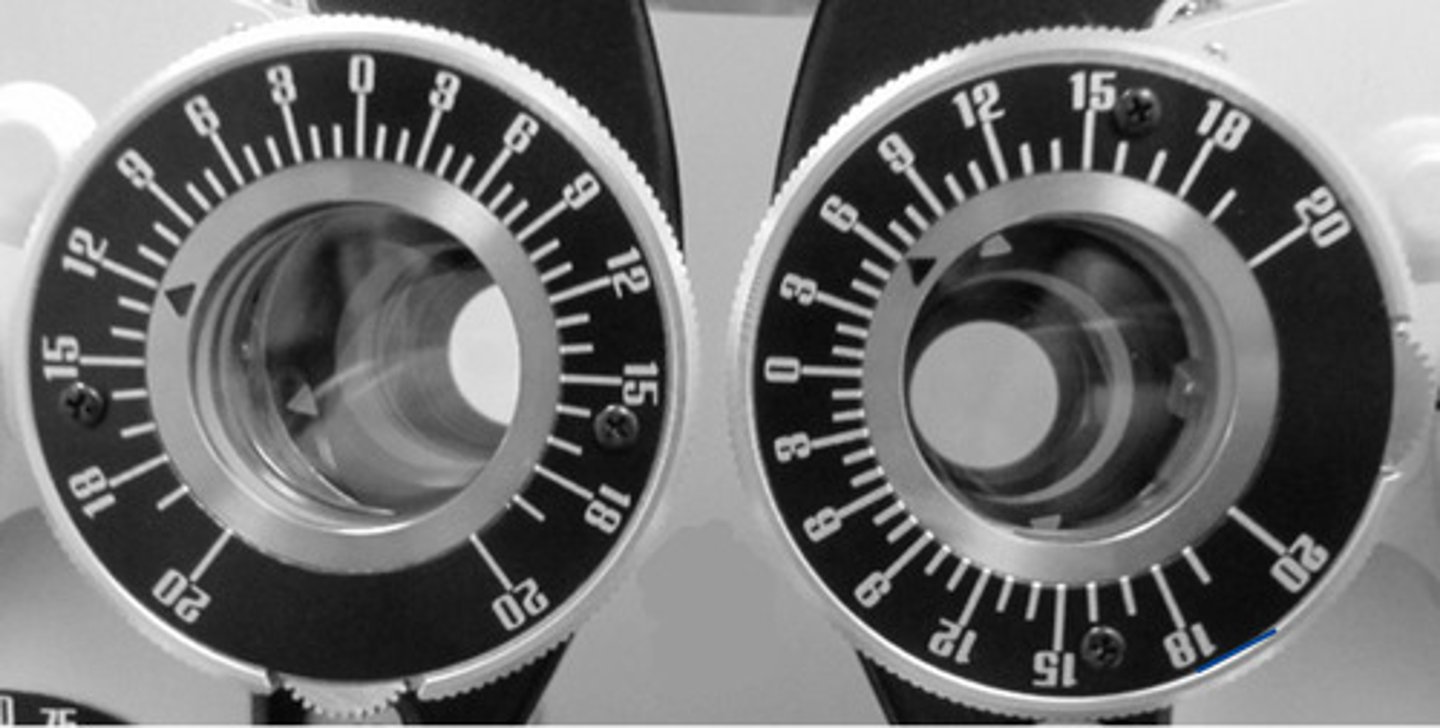
OS
You are measuring a horizontal phoria. Which eye should the patient fixate with?
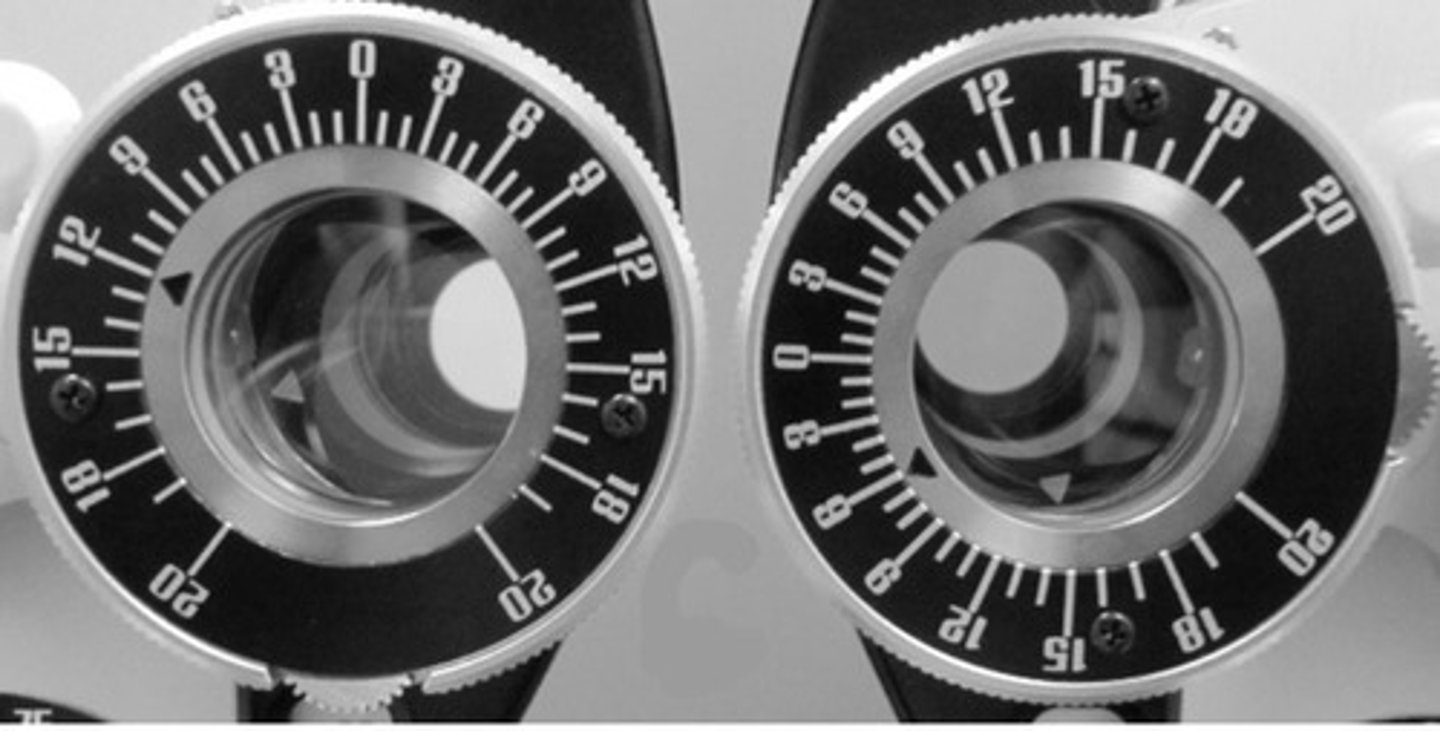
Images have more vertical separation than horizontal separation
What would your patient see if they were a right hyper?
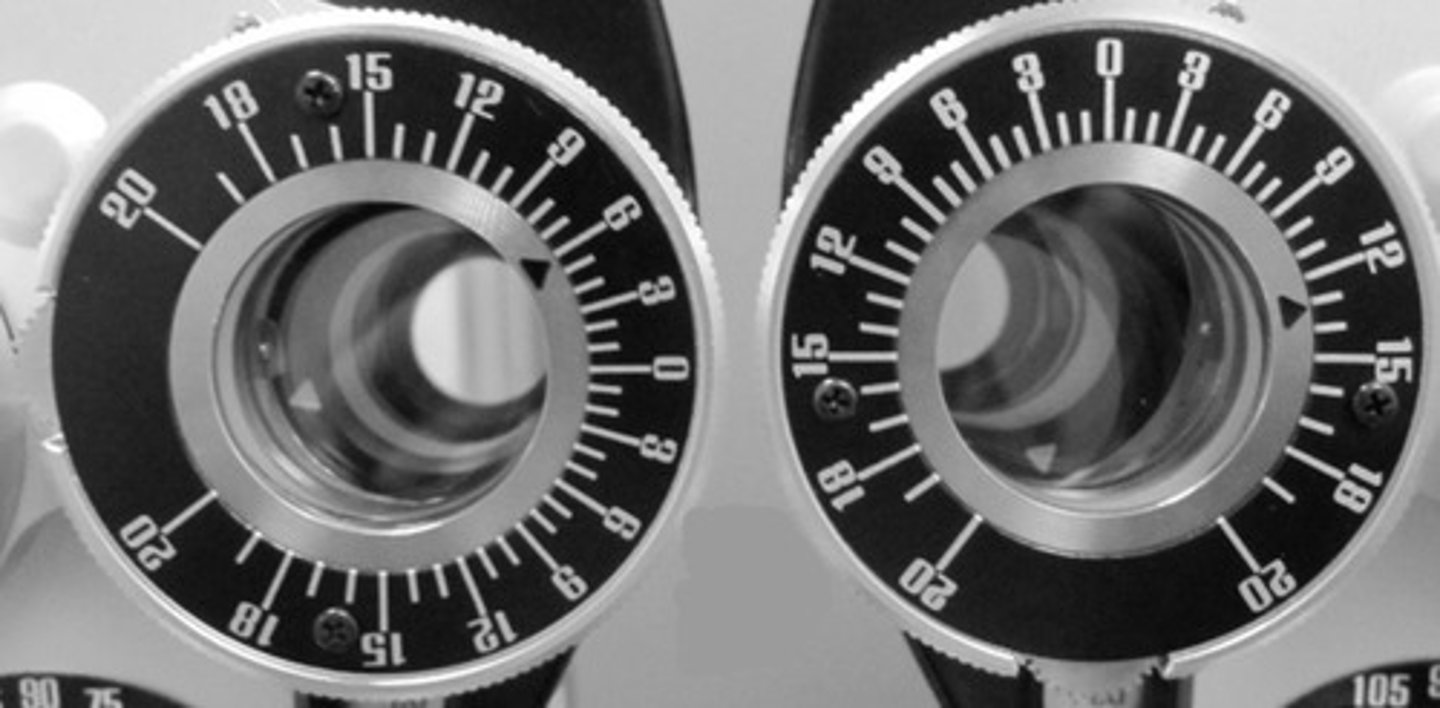
Images vertically stacked on one another
What should your patient see if they were a 12 exo?
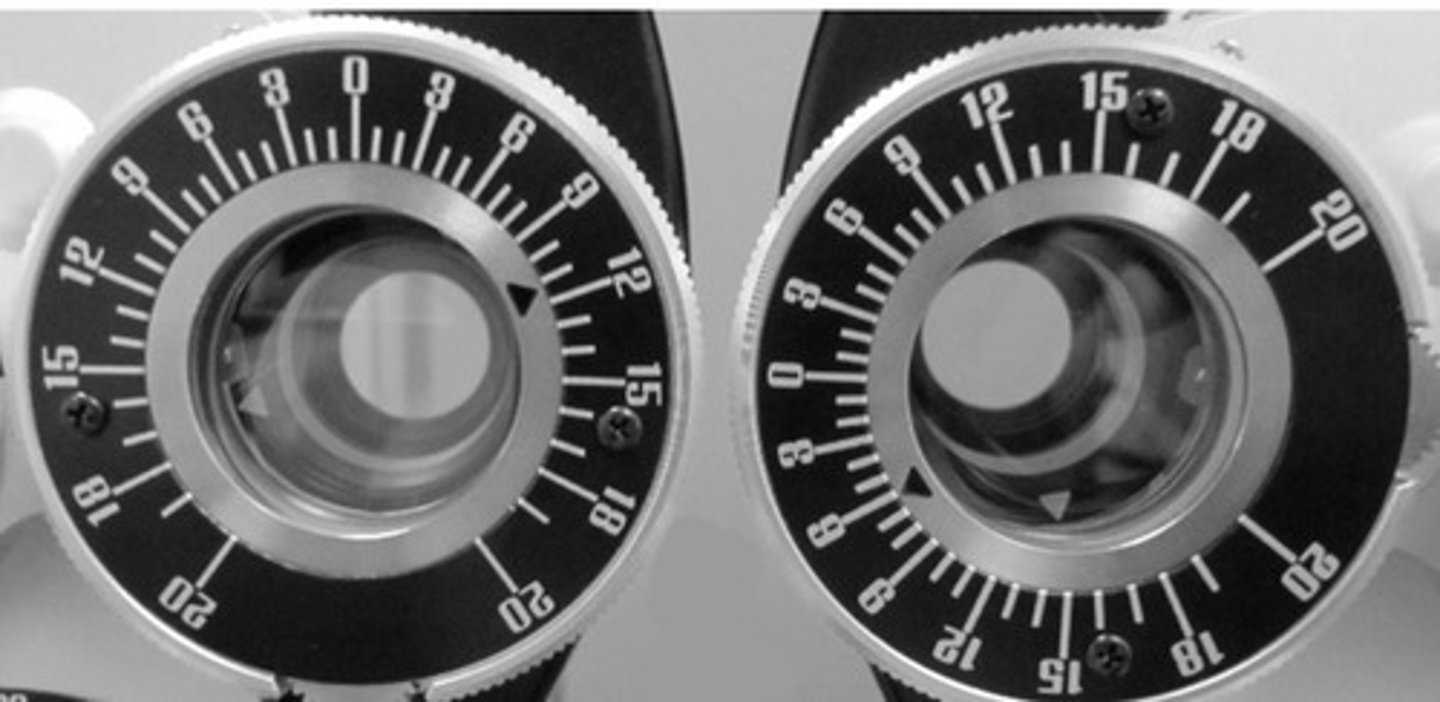
1. make OD 12 BO
2. make OD 24 BI
How would you change the set-up of this to allow a 12 exo patient to see 2 diagonal targets? (Hint: 2 ways)
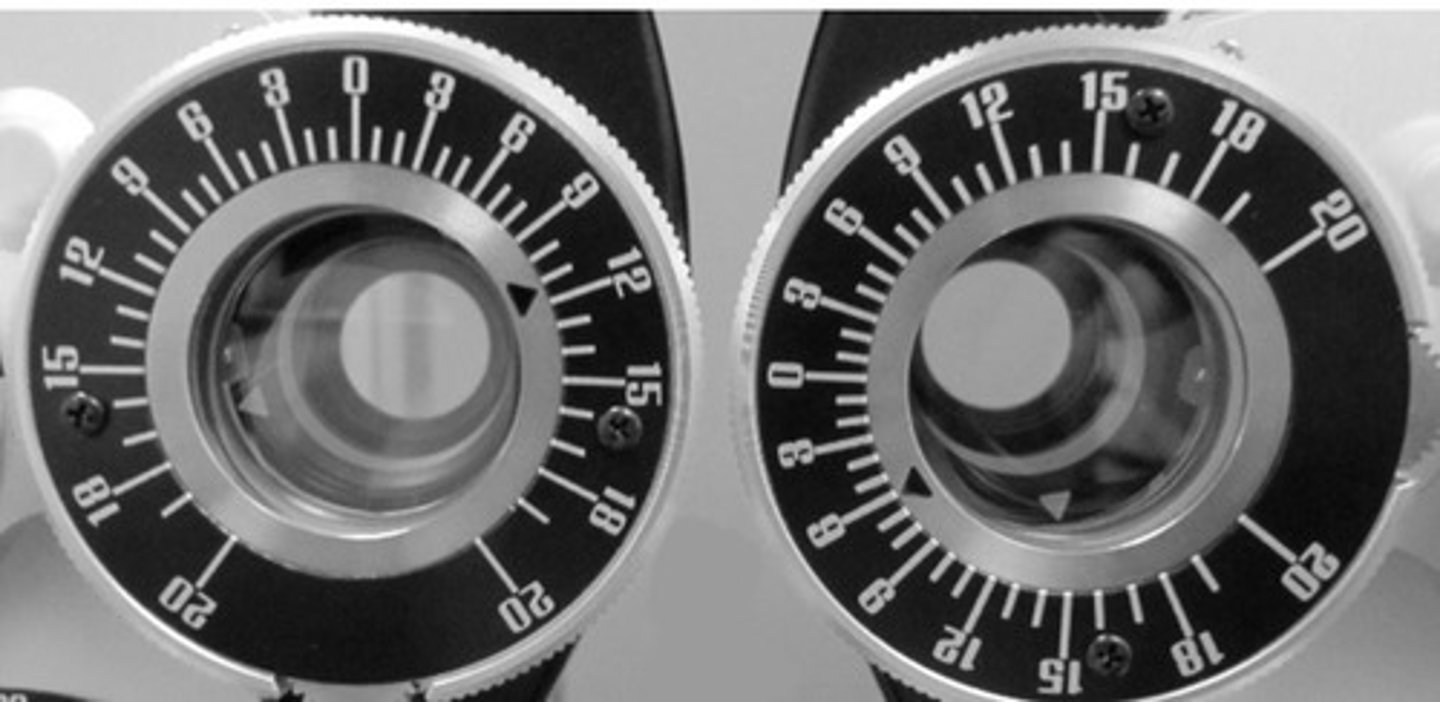
OD: 6 BD
OS: 12 BI
How could you change these prisms, but still have the patient seeing the images from each eye in the same place?
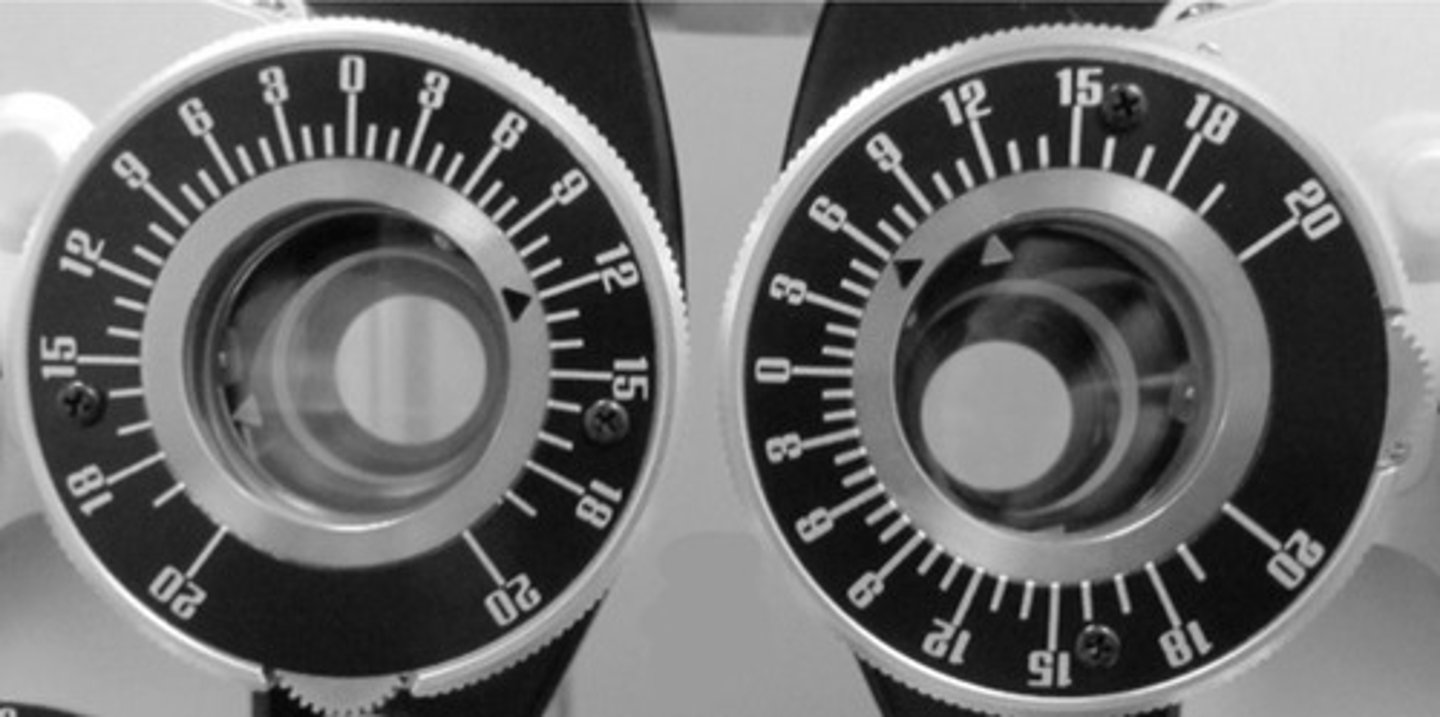
Exo
You are performing the Maddox Rod Test and you cover the right eye. The patient reports seeing a vertical line image to the left of the stimulus. What is the patient's direction of phoria/tropia?
Eso
You are performing the Maddox Rod Test and you cover the right eye. The patient reports seeing a vertical line image to the right of the stimulus. What is the patient's direction of phoria/tropia?
Base in
You are performing the Maddox Rod Test and you cover the right eye. The patient reports seeing a vertical line image to the left of the stimulus. What prism orientation would you use to neutralize this?
Base out
You are performing the Maddox Rod Test and you cover the right eye. The patient reports seeing a vertical line image to the right of the stimulus. What prism orientation would you use to neutralize this?
Crossed
You are performing the Maddox Rod Test and you cover the right eye. The patient reports seeing a vertical line image to the left of the stimulus. What type of disparity is this patient experiencing?
Uncrossed
You are performing the Maddox Rod Test and you cover the right eye. The patient reports seeing a vertical line image to the right of the stimulus. What type of diplopia is this patient experiencing?
Right Hyper (Left Hypo)
You are performing the Maddox Rod Test and you cover the right eye. The patient reports seeing a horizontal line image below the stimulus. What is the patient's direction of phoria/tropia?
Right Hypo (Left Hyper)
You are performing the Maddox Rod Test and you cover the right eye. The patient reports seeing a horizontal line image above the stimulus. What is the patient's direction of phoria/tropia?
OD Base Down (OS Base Up)
You are performing the Maddox Rod Test and you cover the right eye. The patient reports seeing a horizontal line image below the stimulus. What prism orientation would you use to neutralize this?
OD Base Up (OS Base Down)
You are performing the Maddox Rod Test and you cover the right eye. The patient reports seeing a horizontal line image above the stimulus. What prism orientation would you use to neutralize this?
15 XP
When performing the Maddox Rod Test with the Maddox rod over the left eye, the patient reports a vertical line image to the right of the stimulus and requires a 15 BI prism to neutralize. What is this patient's diagnosis?
2 R hyper (2 L Hypo)
When performing the Maddox Rod Test with the Maddox rod over the right eye, the patient reports a horizontal line image below the stimulus and requires a 2 BD over the right eye to neutralize. What is this patient's diagnosis?
8 EP
When performing the Maddox Rod Test with the Maddox rod over the left eye, the patient reports a vertical line image to the left of the stimulus and requires an 8 BO prism to neutralize. What is this patient's diagnosis?
20 EP
When performing the Maddox Rod Test with the Maddox rod over the left eye, the patient reports a vertical line image to the left of the stimulus and requires a 20 BO prism neutralize. What is this patient's diagnosis?
5 L Hypo (5 R Hyper)
When performing the Maddox Rod Test with the Maddox rod over the left eye, the patient reports a horizontal line image above the stimulus and requires a 5 prism over the right eye neutralize. What is this patient's diagnosis?
5 L Hypo (5 R Hyper)
When performing the Maddox Rod Test with the Maddox rod over the left eye, the patient reports a horizontal line image above the stimulus and requires a 5 BU prism over the left eye neutralize. What is this patient's diagnosis?
10 XP
When performing the Maddox Rod Test with the Maddox rod over the right eye, the patient reports a vertical line image to the left of the stimulus and requires a 10 BI prism neutralize. What is this patient's diagnosis?
5Δ eso
When using the Howell Card, a patient sees the following with the prism oriented BD over OS. What is their phoria?
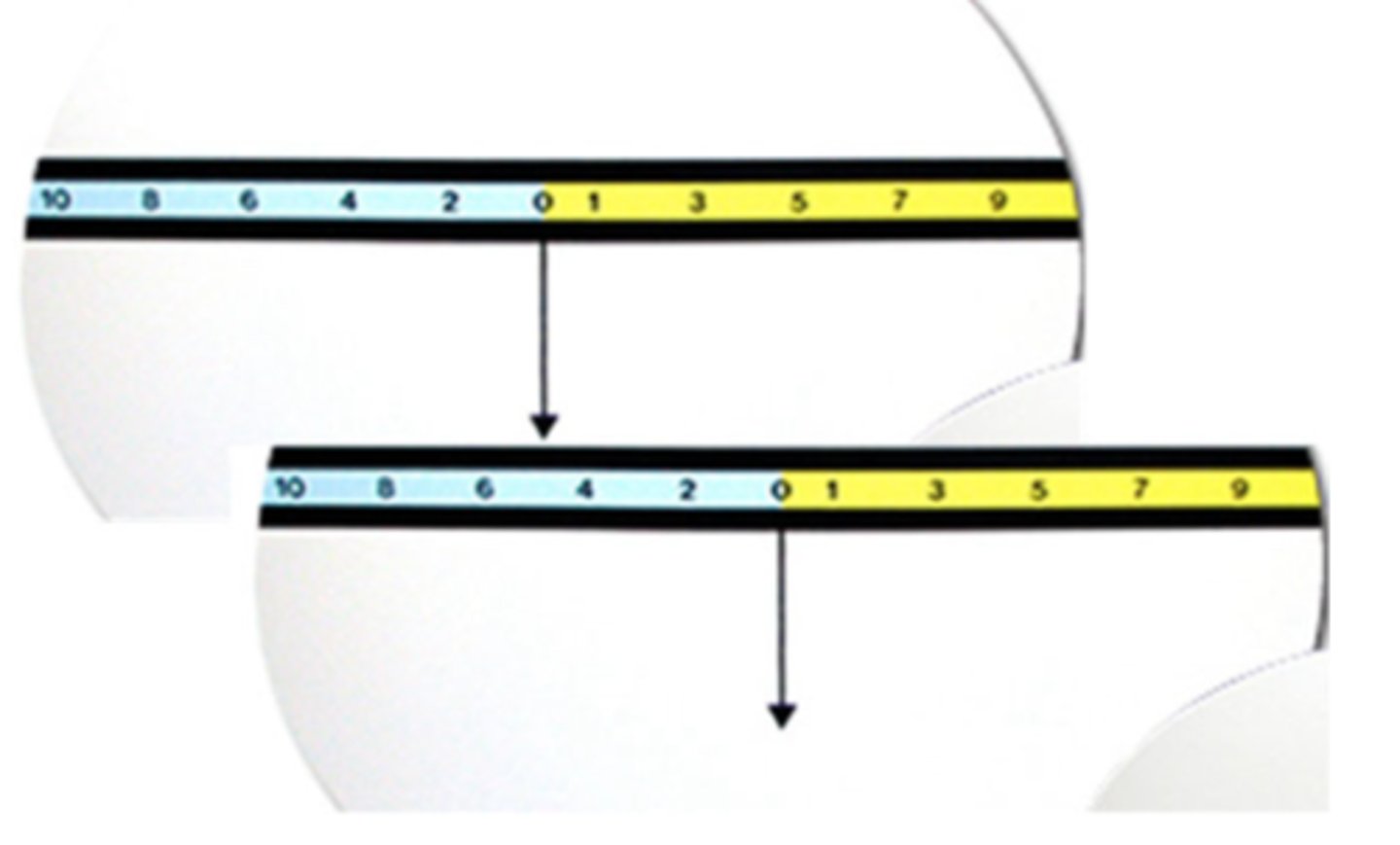
2.5Δ R Hypo (L Hyper)
When using the modified thorington card with the Maddox rod over OD, a patient sees the following. What is their phoria?
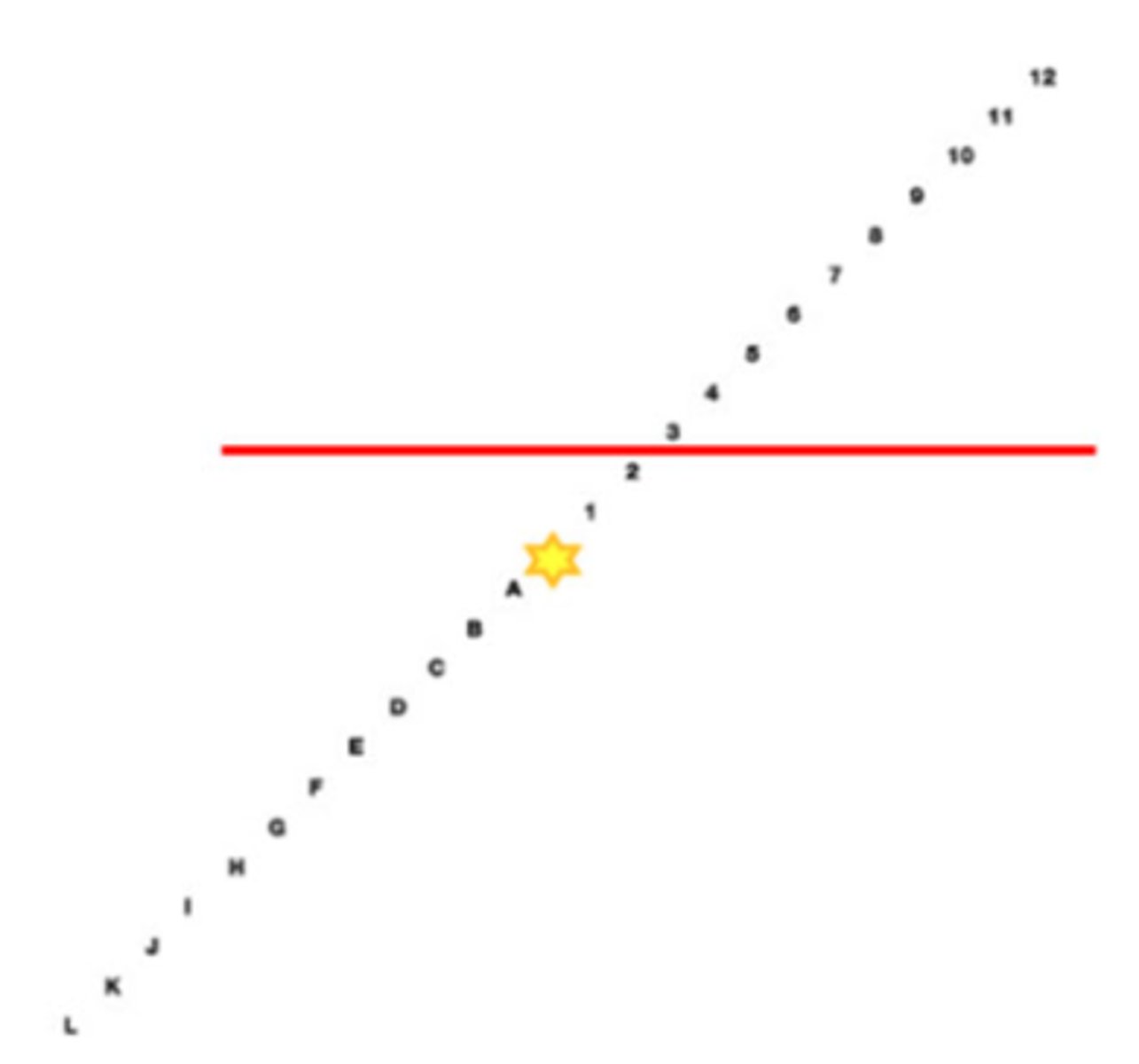
11Δ exo
When using the Saladin card with the Maddox rod over OS, the patient sees the following. What is their phoria?

8Δ exo
When using the modified thorington card with the Maddox rod over OD, a patient sees the following. What is their phoria?

8Δ L Hypo (R Hyper)
When using the Saladin card with the Maddox rod over OS, the patient sees the following. What is their phoria?
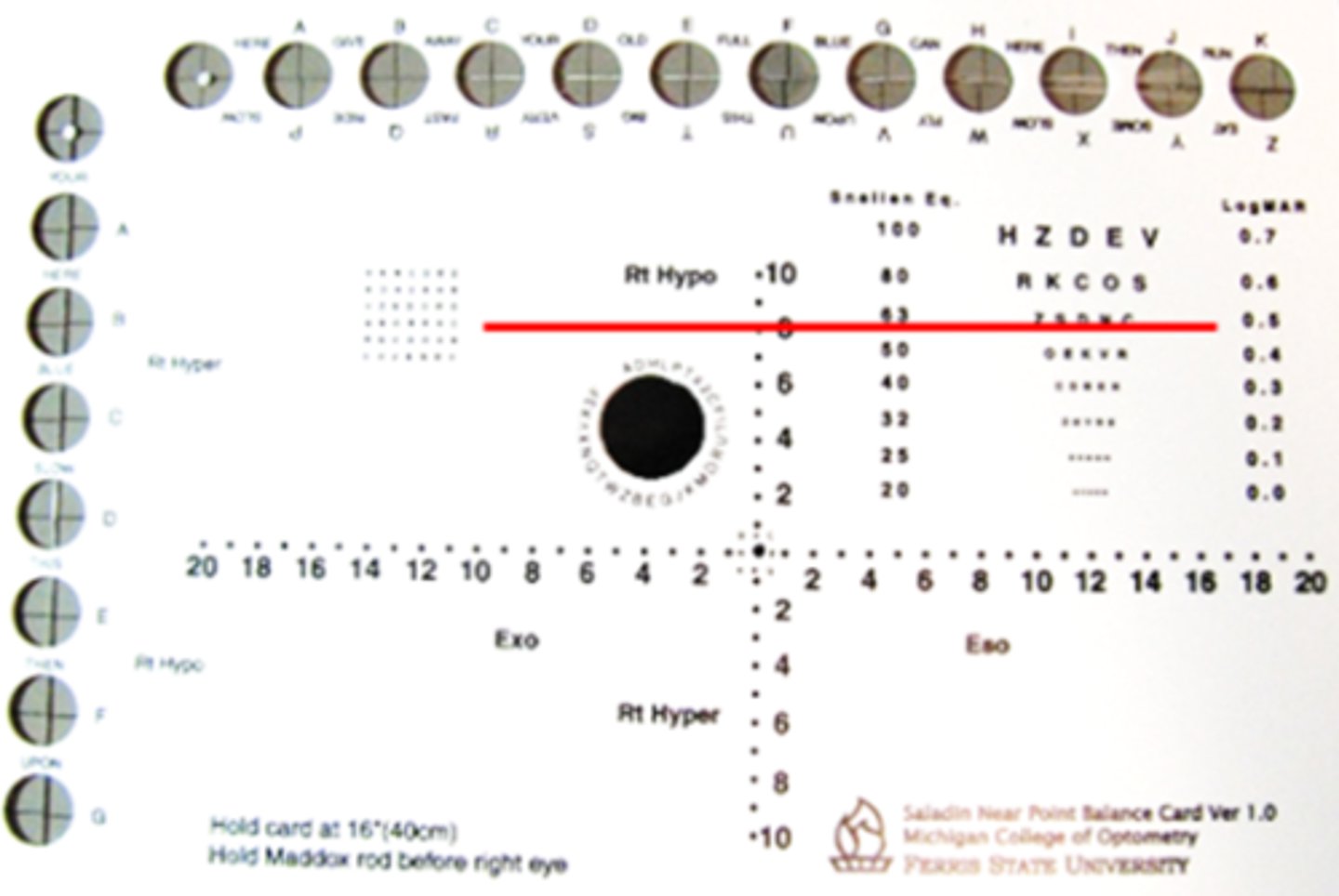
4Δ exo
When using the Howell Card, a patient sees the following with the prism oriented BU over OD. What is their phoria?
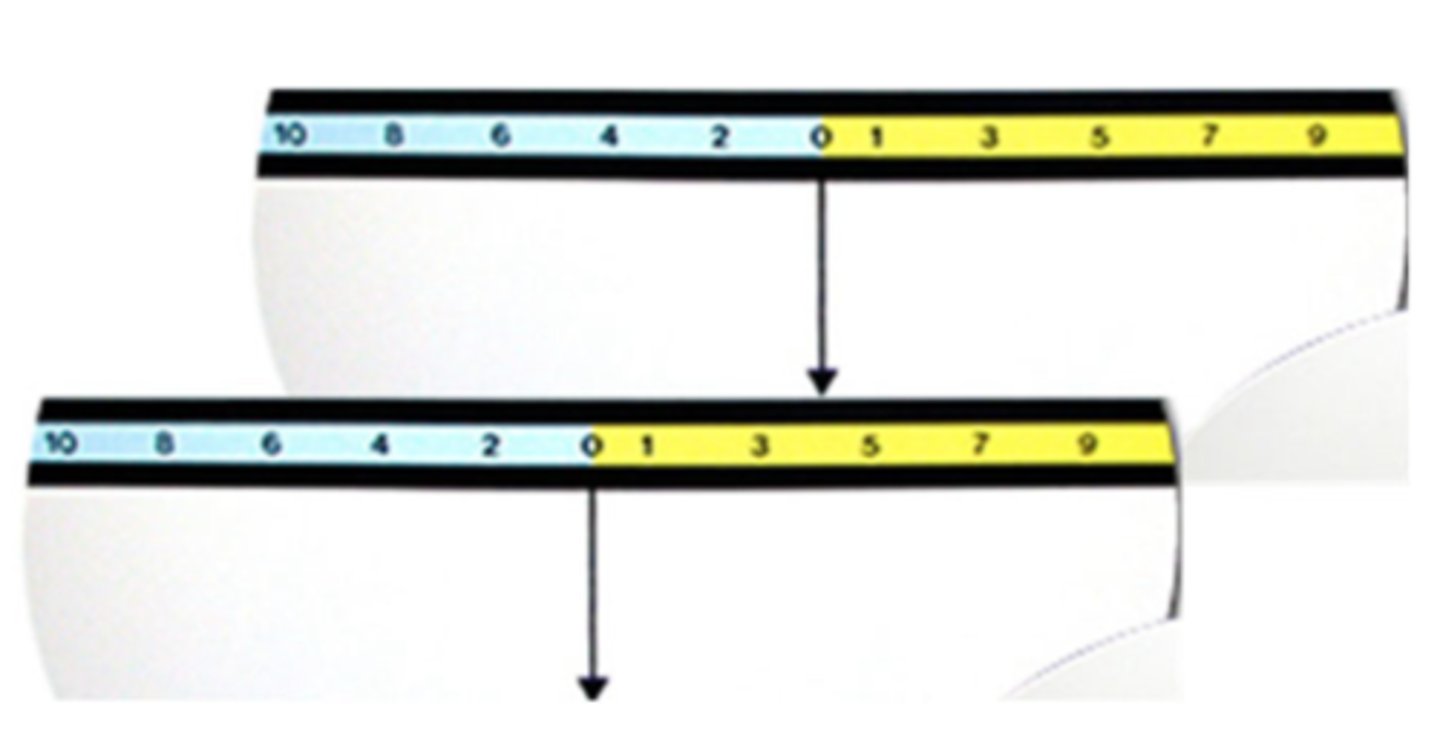
15Δ
At 40 cm a patient has a PD of 60mm. What is their convergence demand?
16Δ
At 40 cm a patient has a PD of 64mm. What is their convergence demand?
17Δ
At 40 cm a patient has a PD of 68mm. What is their convergence demand?
4mm
For a 40cm working distance, a ________mm change in PD equals 1Δ change in convergence demand
0D
What is the accommodative demand for a distant stimulus?
2D
What is the accommodative demand for a stimulus located 50cm away?
2.5D
What is the accommodative demand for a stimulus located 40cm away?
3D
What is the accommodative demand for a stimulus located 33cm away?
4D
What is the accommodative demand for a stimulus located 25cm away?
6Δ/D
For a patient that is ortho at distance and at near, what is their AC/A ratio with a working distance of 40cm and a PD of 60mm?
6Δ/D
For a patient that is 4Δ exo at distance and 4Δ exo at near, what is their AC/A ratio with a working distance of 40cm and a PD of 60mm?
2Δ eso
For a patient that has a 60mm PD is 4Δ exo at distance and 4Δ exo at 40cm with their BCVA. At near what phoria would you expect them to have with a -1.00D lens over their eyes?
6Δ/D
For a patient that is 8Δ eso at distance and 8Δ eso at near, what is their AC/A ratio with a working distance of 40cm and a PD of 60mm?
4Δ exo
For a patient that has a 60mm PD is 8Δ eso at distance and 8Δ eso at 40cm with their BCVA. What phoria would you expect them to have with at near with a +2.00D lens over their eyes?
14Δ eso
For a patient that has a 60mm PD is 8Δ eso at distance and 8Δ eso at 40cm with their BCVA. At near what phoria would you expect them to have with -1.00D lens over their eyes?
2.8Δ/D
For a patient that is 4Δ eso at distance and 4Δ exo at near, what is their AC/A ratio with a working distance of 40cm and a PD of 60mm?
11.2Δ/D
For a patient that is 6Δ exo at distance and 6Δ eso at near, what is their AC/A ratio with a working distance of 40cm and a PD of 64mm?
10.8Δ/D
For a patient that is ortho at distance and 10Δ eso at near, what is their AC/A ratio with a working distance of 50cm and a PD of 58mm?
11.2Δ/D
For a patient that is 15Δ exo at distance and ortho at near, what is their AC/A ratio with a working distance of 33cm and a PD of 62mm?
8Δ/D
For a patient that is 8Δ eso at distance and 12Δ eso at near, what is their AC/A ratio with a working distance of 40cm and a PD of 64mm?
2Δ/D
For a patient that has a PD or 60mm, they are 5Δ exo at a working distance of 50cm and 7Δ exo at a working distance of 40cm. What is their AC/A ratio?
16Δ/D
For a patient that is 2Δ eso at distance and 6Δ exo at near through a +2.00D add, what is their AC/A ratio with a working distance of 40cm and a PD of 64mm?
1Δ exo
For a patient that has an AC/A ratio of 8Δ/D with a working distance of 40 cm and a PD of 60mm. What is their distance phoria if their near phoria is 4Δ eso?
A. 2
B. 1
C. 3
D. 5
E. 4
Assuming the same PD and WD for each, rank the following phorias in order from highest to lowest (1-5). Each is shown as distance phoria / near phoria.
A. Ortho / 10Δ eso
B. 10Δ exo / 10 Δ eso
C. Ortho / Ortho
D. 10Δ eso / 10Δ exo
E. Ortho / 10Δ exo
2Δ/D
When performing cover test, your patient measures 6XP at distance through the BVA. A repeat cover test through -1.00D lenses on top of the BVA reveals a 4XP. What is the gradient AC/A?
6Δ/D
When performing Von Graefe, your patient measures 4 exo at 40cm through his BVA. He measures 2 eso with a -1.00D lens. What is his AC/A?
8Δ/D
Your patient measures 6 eso at near through his BVA. He measures 10 exo with a +2.00D lens. What is his gradient AC/A?
fusion
If a patient sees this during worth dot then they are experiencing

diplopia
If a patient sees this during worth dot, then they are experiencing what?

OD suppression
If a patient sees this during worth dot, then they are experiencing what?

OS suppression
If a patient sees this during worth dot, then they are experiencing what?

crossed retinal disparity
What type of disparity is this?

exotropia
What type of tropia does this patient have?

Fusion with intermittent suppression of OS
If the patient see this, but the green lights are flashing on and off, what does that indicate?

BU over OD (or BD over OS)
What base prism (over which eye) would this patient need?

large BI prism
Starting with this image, what type of prism would you use to induce diplopia with red lights on the right?

- BO
- BU over OS (or BD over OD)
Which 2 types of prism would you need (and which eye) to have the patient fused these dots?

deep suppression of OD at distance and near
Your patient sees the following at all distances, in dark illumination. How would you describe the suppression?

12Δ exo
A patient has a PD of 72mm. For the cover test at distance they are 4XP, and at 40cm a 3EP. NRA value is +2.50 and PRA is -1.50.
What would their near alignment be through a +1.50D lens?
15Δ BI
A patient has a PD of 72mm. For the cover test at distance they are 4XP, and at near a 3EP. NRA value is +2.50 and PRA is -1.50.
What is the patient's expected NRV at near?
+2.00D
A patient has a PD of 72mm. For the cover test at distance they are 4XP, and at near a 3EP. NRA value is +2.50 and PRA is -1.50.
If the patient's BO at near is 20/26/24, what would expect the NRA to be?
30Δ
A patient has a PD of 72mm. For the cover test at distance they are 4XP, and at near a 3EP. NRA value is +2.50 and PRA is -1.50.
If the patient's BO at near is 20/26/24, what would you expect the PRV to be through a -1.00 lens?
10Δ
A patient has a PD of 72mm. For the cover test at distance they are 4XP, and at near a 3EP. NRA value is +2.50 and PRA is -1.50.
If the patient's BO at near is 20/26/24, what would you expect the PRV to be through a +1.00 lens?
+2.50/+2.75
PD: 64mm.
CT at 6m: ortho
CT at 40cm: 6XP.
BI at near: 12/15/10
BO at near: 16/20/18
What would expect as the NRA?
-3.00
PD: 64mm.
CT at 6m: ortho
CT at 40cm: 6XP.
BI at near: 12/15/10
BO at neat 16/20/18
What would expect as the PRA?
22Δ
PD: 64mm.
CT at 6m: ortho
CT at 40cm: 6XP.
BI at near: 12/15/10
BO at neat 16/20/18
What would expect as the PFV?
6Δ
PD: 64mm.
CT at 6m: ortho
CT at 40cm: 6XP.
BI at near: 12/15/10
BO at neat 16/20/18
What would expect as the NFV?
12Δ
PD: 64mm.
CT at 6m: ortho
CT at 40cm: 6XP.
BI at near: 12/15/10
BO at neat 16/20/18
What would expect as the PRV through +1.00D lenses?
16Δ
PD: 64mm.
CT at 6m: ortho
CT at 40cm: 6XP.
BI at near: 12/15/10
BO at neat 16/20/18
What would expect as the NRV through +1.00D lenses?
24Δ
PD: 64mm.
CT at 6m: ortho
CT at 40cm: 6XP.
BI at near: 12/15/10
BO at neat 16/20/18
What would expect as the PRV through -2.00D lenses?
4Δ
PD: 64mm.
CT at 6m: ortho
CT at 40cm: 6XP.
BI at near: 12/15/10
BO at neat 16/20/18
What would expect as the NRV through -2.00D lenses?
18Δ
For an ortho patient, assume that blur occurs at 12 BI, and 18 BO. What is their PRV?
12Δ
For an ortho patient, assume that blur occurs at 12 BI, and 18 BO. What is their NFV?
12Δ
For an ortho patient, assume that blur occurs at 12 BI, and 18 BO. What is their NRV?
18Δ
For a patient with 4Δ XP, assume that blur occurs at 12 BI, and 18 BO. What is their PRV?
22Δ
For a patient with 4Δ XP, assume that blur occurs at 12 BI, and 18 BO. What is their PFV?
12Δ
For a patient with 4Δ XP, assume that blur occurs at 12 BI, and 18 BO. What is their NRV?
8Δ
For a patient with 4Δ XP, assume that blur occurs at 12 BI, and 18 BO. What is their NFV?
18Δ
For a patient with 8Δ XP, assume that blur occurs at 12 BI, and 18 BO. What is their PRV?
12Δ
For a patient with 8Δ XP, assume that blur occurs at 12 BI, and 18 BO. What is their NRV?
26Δ
For a patient with 8Δ XP, assume that blur occurs at 12 BI, and 18 BO. What is their PFV?
4Δ
For a patient with 8Δ XP, assume that blur occurs at 12 BI, and 18 BO. What is their NFV?
2Δ right hyper
You are measuring vertical phorias on a patient that has an OD supra 6/4 and an OD infra 2/0, this patient is